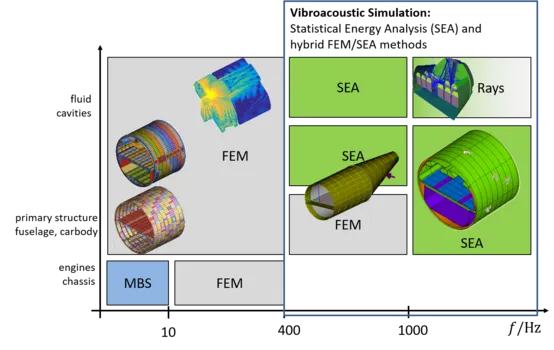Vibroacoustic Simulation - Statistical Energy Analysis and Hybrid Methods
Supplementary Course (English), 2 SWH, summer semester
| Lecturer (assistant) | |
|---|---|
| Language of instruction | English |
| Dates | See TUMonline |
Content
Wave-based methods, like the Finite-Element Method (FEM) or the Boundary-Element Method (BEM), have traditionally dominated the analysis of structural vibrations and acoustics. While they are excellent at capturing the intricacies of wave propagation, they encounter challenges when dealing with complex, large-scale structures or the high-frequency domain. The inherent challenges posed by large-scale structures, high frequencies, and the need for real-world applicability motivate the integration of energy-based methods. Statistical Energy Analysis (SEA) excels in quantifying energy distribution within complex structures, providing a macroscopic view that complements the microscopic insights offered by traditional wave-based methods. This holistic approach allows engineers to predict and control noise levels, offering a nuanced understanding of how energy propagates and transforms within a given system. By seamlessly integrating the strengths of both approaches, Hybrid Methods offer a comprehensive understanding of the system, overcoming the limitations inherent in singular methodologies.

- ... model and calculate complex vibroacoustic systems in the mid and higher frequency range.
- ... apply the method of Statistical Energy (Flow) Analysis (SEA).
- ... apply the Hybrid FEM/SEA Method.
- ... describe statistical systems by diffuse wave fields and their power balance.
- ... calculate the properties of airborne and structure-borne sound sources.
- ... determine the coupling between deterministic and statistical systems.
- ... establish, solve, and interpret the power flow matrix of the overall system.
- ... understand systems that contain deterministic and statistical subsystems through hybrid approaches.
- ... determine the response of vibroacoustic systems and optimize them (acoustic noise control measures)
Organizational Matters
Lecture:
- weekly regular class, 2 SWH per lecture
- Lecture content is presented with the aid of presentation slides and additional digital media. Practical exercises are included in which the topic is presented based on example simulations using the python toolbox pyva. The module concludes with application examples from industry.
Examination:
- The examination will be held as a written exam (duration: 60 minutes)